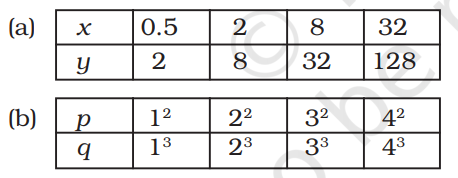In the following questions, which of them vary directly and which vary inversely with each other and which are neither of the two?
(i) The time taken by a train to cover a fixed distance and the speed of the train.
(ii) The distance travelled by CNG bus and the amount of CNG used.
(iii) The number of people working and the time to complete a given work.
(iv) Income tax and the income
(v) Distance travelled by an auto-rickshaw and time taken
To determine whether the given pairs of quantities vary directly, inversely, or neither, we can analyze each pair step by step.
Step 1: Analyze the first pair
(i) The time taken by a train to cover a fixed distance and the speed of the train.
- Explanation: Speed is defined as distance divided by time. If the distance is fixed, then speed is inversely proportional to time. As speed increases, the time taken decreases.
- Conclusion: This varies inversely.
Step 2: Analyze the second pair
(ii) The distance travelled by a CNG bus and the amount of CNG used.
- Explanation: If 1 litre of CNG allows the bus to travel a certain distance, then more CNG will allow it to travel a greater distance. Thus, the distance travelled is directly proportional to the amount of CNG used.
- Conclusion: This varies directly.
Step 3: Analyze the third pair
(iii) The number of people working and the time to complete a given work.
- Explanation: If more people are working, the time taken to complete the work decreases. This means that the number of people is inversely proportional to the time taken.
- Conclusion: This varies inversely.
Step 4: Analyze the fourth pair
(iv) Income tax and the income.
- Explanation: As income increases, the income tax also increases (assuming a fixed tax rate). This indicates a direct relationship between income and income tax.
- Conclusion: This varies directly.
Step 5: Analyze the fifth pair
(v) Distance travelled by an auto-rickshaw and time taken.
- Explanation: The distance travelled is directly proportional to the time taken, assuming a constant speed. If the time taken increases, the distance travelled also increases.
- Conclusion: This varies directly.
Final Summary:
1. Time taken by a train and speed of the train: Inversely proportional
2. Distance travelled by CNG bus and amount of CNG used: Directly proportional
3. Number of people working and time to complete a given work: Inversely proportional
4. Income tax and income: Directly proportional
5. Distance travelled by an auto-rickshaw and time taken: Directly proportional
---
(i) The time taken by a train to cover a fixed distance and the speed of the train.
- Conclusion: This varies inversely.
(ii) The distance travelled by a CNG bus and the amount of CNG used.
- Conclusion: This varies directly.
(iii) The number of people working and the time to complete a given work.
- Conclusion: This varies inversely.
(iv) Income tax and the income.
- Conclusion: This varies directly.
(v) Distance travelled by an auto-rickshaw and time taken.
- Conclusion: This varies directly.
1. Time taken by a train and speed of the train: Inversely proportional
2. Distance travelled by CNG bus and amount of CNG used: Directly proportional
3. Number of people working and time to complete a given work: Inversely proportional
4. Income tax and income: Directly proportional
5. Distance travelled by an auto-rickshaw and time taken: Directly proportional
Topper's Solved these Questions
- DIRECT AND INVERSE PROPORTIONS BOOK - NCERT EXEMPLARCHAPTER - DIRECT AND INVERSE PROPORTIONS EXERCISE - THINK AND DISCUSS
2 Videos
- DIRECT AND INVERSE PROPORTIONS BOOK - NCERT EXEMPLARCHAPTER - DIRECT AND INVERSE PROPORTIONS EXERCISE - THINK AND DISCUSS
2 Videos
- DATA HANDLINGBOOK - NCERT EXEMPLARCHAPTER - DATA HANDLINGEXERCISE - EXERCISE
73 Videos
- EXPONENTS AND POWERSBOOK - NCERT EXEMPLARCHAPTER - EXPONENTS AND POWERSEXERCISE - EXERCISE
195 Videos
Similar Questions
Which of the following vary inversely with each other?
View SolutionIn the following questions, which of them vary directly and which vary inversely with each other and which are neither of the two?
(i) Number of students in a hostel and consumption of food
(ii) Area of the walls of a room and the cost of white washing the walls.
(iii) The number of people working and the quantity of work.
(iv) Simple interest on a given sum and the rate of interest
(v) Compound interest on a given sum and the sum invested.
View Solution
Knowledge Check
Which of the following vary inversely with each other?
Aspeed and distance coveredBspeed and time takenCdistance travelled and time takenDdistance covered and fare paidThe distance between two stations is 240 km. A train takes 4 hours to cover this distance. Calculate the speed of the train.
A40 km h−1B50 km h−1C60 km h−1D70 km h−1A train covers a certain distance in 210 minute at a speed of 60 kmph the time taken by the train, to cover the same distance at a speed of 80 kmph is—
A3 hoursB358 hoursC258 hoursD4(58) hours
In the following questions, which of them vary directly and which vary inversely with each other and which are neither of the two?
(i) The quantity of rice and its cost.
(ii) The height of a tree and the number of years.
(iii) Increase in cost and number of shirts that can be purchased if the budget remains the same
(iv) Area of land and its cost
(v) Sales Tax and the amount of the bill
View SolutionWhich quantities in the previous question vary inversely with each other?


View SolutionWhen the speed is kept fixed, time and distance vary inversely with each other
View SolutionThe distance between two stations is 480 km. A train takes 6 hours to cover this distance. Calculate the speed of the train.
View SolutionThe distance between two stations is 240 km. A train takes 4 hours to cover this distance. Calculate the speed of the train.
View Solution
